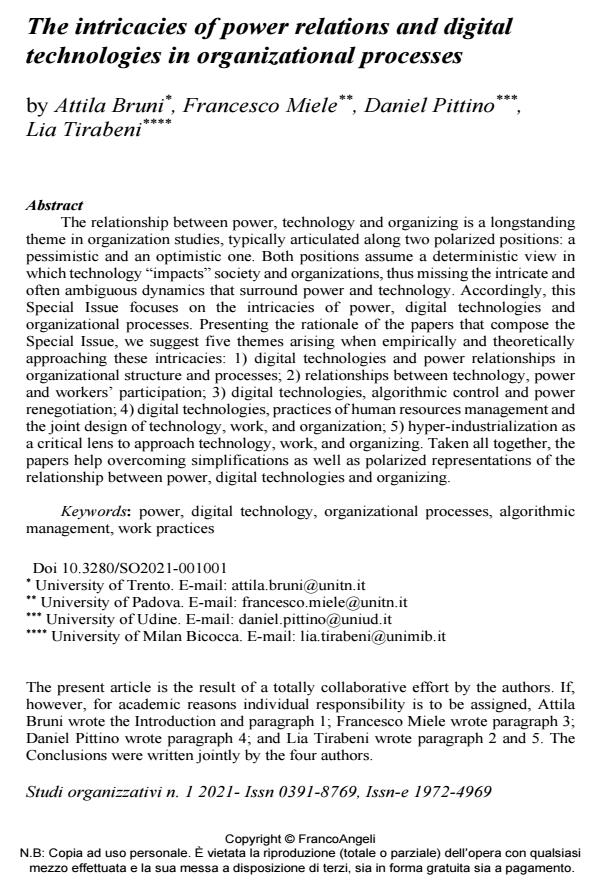The intricacies of power relations and digital technologies in organizational processes
Titolo Rivista STUDI ORGANIZZATIVI
Autori/Curatori Attila Bruni, Francesco Miele, Daniel Pittino, Lia Tirabeni
Anno di pubblicazione 2021 Fascicolo 2021/1
Lingua Inglese Numero pagine 18 P. 7-24 Dimensione file 238 KB
DOI 10.3280/SO2021-001001
Il DOI è il codice a barre della proprietà intellettuale: per saperne di più
clicca qui
Qui sotto puoi vedere in anteprima la prima pagina di questo articolo.
Se questo articolo ti interessa, lo puoi acquistare (e scaricare in formato pdf) seguendo le facili indicazioni per acquistare il download credit. Acquista Download Credits per scaricare questo Articolo in formato PDF

FrancoAngeli è membro della Publishers International Linking Association, Inc (PILA)associazione indipendente e non profit per facilitare (attraverso i servizi tecnologici implementati da CrossRef.org) l’accesso degli studiosi ai contenuti digitali nelle pubblicazioni professionali e scientifiche
The relationship between power, technology and organizing is a longstanding theme in organization studies, typically articulated along two polarized positions: a pessimistic and an optimistic one. Both positions assume a deterministic view in which technology "impacts" society and organizations, thus missing the intricate and often ambiguous dynamics that surround power and technology. Accordingly, this Special Issue focuses on the intricacies of power, digital technologies and organizational processes. Presenting the rationale of the papers that compose the Special Issue, we suggest five themes arising when empirically and theoretically approaching these intricacies: 1) digital technologies and power relationships in organizational structure and processes; 2) relationships between technology, power and workers’ participation; 3) digital technologies, algorithmic control and power renegotiation; 4) digital technologies, practices of human resources management and the joint design of technology, work, and organization; 5) hyper-industrialization as a critical lens to approach technology, work, and organizing. Taken all together, the papers help overcoming simplifications as well as polarized representations of the relationship between power, digital technologies and organizing.
La relazione tra potere, tecnologia e processi organizzativi è un tema di lunga data negli studi organizzativi, tipicamente articolato lungo due principali posizioni polarizzate: una pessimistica e una ottimistica, entrambe caratterizzate da una visione deterministica per cui la tecnologia "impatta" la società e le organizzazioni. A ben vedere, tuttavia, questa visione deterministica manca di cogliere le complesse, e spesso ambigue, dinamiche che caratterizzano la relazione fra potere e tecnologia. Il presente Special Issue si focalizza al contrario sulle complessità della relazione fra potere, tecnologie digitali e processi organizzativi. Nel presentare le ragioni degli articoli che compongono lo Special Issue, si suggeriscono cinque tematiche emergenti quando si approcciano empiricamente e teoricamente tali complessità: 1) tecnologie digitali e relazioni di potere nella struttura e nei processi organizzativi; 2) il legame fra tecnologia, potere e partecipazione dei lavoratori; 3) tecnologie digitali, controllo algoritmico e rinegoziazione del potere; 4) tecnologie digitali, pratiche di gestione delle risorse umane e progettazione congiunta di tecnologia, lavoro e organizzazione; 5) l’iperindustrializzazione come approccio critico per meglio comprendere la relazione fra tecnologia, lavoro e organizzazione. Presi insieme, questi articoli vanno oltre la semplificazione e la polarizzazione che caratterizza il dibattito e offrono una rappresentazione sfumata della relazione fra potere, tecnologia e organizzazione.
Parole chiave:potere, tecnologia digitale, processi organizzativi, gestione algoritmica, pratiche di lavoro
- RETRACTED ARTICLE: Beyond the Swipe: Investigating the Interplay of Technology, Media, and Human Behavior in Digital Romance Ning Li, Bin Wang, Yanglin Li, Hao Pang, Xingzhi Han, in Journal of the Knowledge Economy /2024 pp.6124
DOI: 10.1007/s13132-024-01802-6 - Diversity and Inclusion in Italy Attila Bruni, pp.663 (ISBN:978-3-031-81937-7)
- Navigating Digital Transformation Lia Tirabeni, pp.113 (ISBN:978-3-031-76969-6)
- Engaging the body, appropriating a corporate wellness programme Enrico Attila Bruni, Filippo Andrei, Lia Tirabeni, in Qualitative Research in Organizations and Management: An International Journal /2022 pp.88
DOI: 10.1108/QROM-02-2022-2296 - Integration of parametric modeling tools in small architectural offices – between constraints and organizational strategies Adeline Stals, Catherine Elsen, Sylvie Jancart, in Architectural Engineering and Design Management /2022 pp.759
DOI: 10.1080/17452007.2022.2050347 - Reintroducing technology to the coworking debate: prospects and problematics Maddalena Sorrentino, Lia Tirabeni, Maria Laura Toraldo, in STUDI ORGANIZZATIVI 2/2023 pp.70
DOI: 10.3280/SO2022-002003
Attila Bruni, Francesco Miele, Daniel Pittino, Lia Tirabeni, The intricacies of power relations and digital technologies in organizational processes in "STUDI ORGANIZZATIVI " 1/2021, pp 7-24, DOI: 10.3280/SO2021-001001